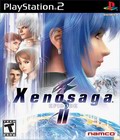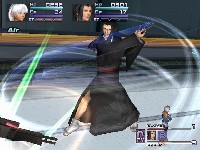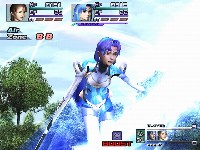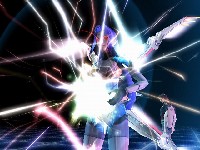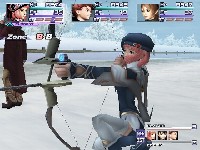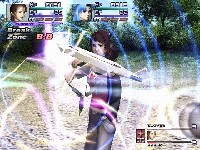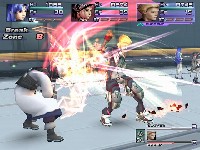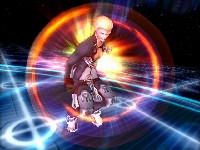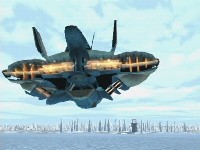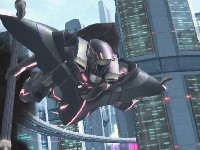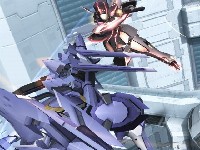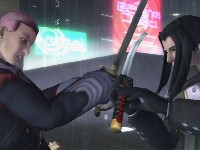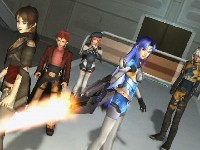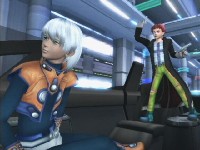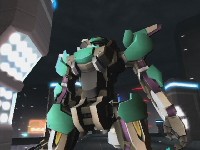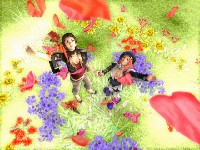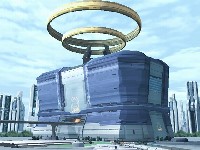Genre: RPG
Publisher: Namco
Developer: Monolith Soft
Release Date: February 15, 2005
Buy 'XENOSAGA II': PlayStation 2
Monolith Software’s well-known ongoing RPG series, Xenosaga, recently saw the second entry in it’s saga, and the third in the entire franchise, considering the Playstation Xenogears. The first title was highly acclaimed, and while it was released towards the very end of the original Playstation’s lifespan, it gained quite a following of interested fans. It made sense that a sequel would see light on Playstation 2 soon afterward.
That game was Xenosaga Episode I: Der Wille zur Macht (The Will to Power), and received mixed reviews upon its release. While many enjoyed the game’s complex battle system and character development, there was no denying it was heavy on story – it wasn’t uncommon to see a player spend sixty hours before seeing completion, and a large number of those hours were in fact spent watching the cinemas in the game. It packed some very long motion clips; up to forty minutes at a time in places was seen here. While the story was certainly interesting enough to warrant it, it became more of an epic film than a game.
Taking that into consideration, Monolith Software crafted Xenosaga II: Jenseits von Gut und Bose (Beyond Good and Evil) with more gameplay time and less movie time. While there are still plenty of videos to feast your eyes on – some of them quite impressive – the total game length has also been suckered down to less than half of its predecessors, coming in at around twenty-five hours this time.
The game picks up almost exactly were Episode I left off, barring a short flashback in the beginning that introduces two of the new characters, Canaan, and the brother of Shion, Jin Uzuki. Players will be glad to then see the return of familiar characters KOS-MOS, Shion, Junior, MOMO, Ziggy, chaos, and others, save for some moderate changes. This time around, Monolith dropped the anime stylized look of the characters in favor of a more realistic, proportionate one. It’s not unwelcome. While, for instance, KOS-MOS looked fine before, she looks even better now, with a strikingly pretty face accompanying more detailed armor on her body. The other big change are the voice actors for the characters. A few stay the same, but many are different, for better or worse: there is a definite improvement in chaos, but KOS-MOS sounds downright awful now.
The cast isn’t the only thing that Monolith decided to change up. There are a number of changes, some small, some large, some good and some bad, in this episode of the saga. On a fairly important note, character development has been completely dumbed down. While it was a pretty deep affair in the original, where distributing several different kinds of points to different characters resulted in many different variations, the same isn’t true here. Now there’s only one type of experience to be gained, and it really can’t affect the characters in different ways.
Also of note is the completely missing monetary system. There is no money in the game. You can’t walk into a shop and buy a healing item anymore. Instead, you must receive items from fallen enemies in battle. This is pretty ridiculous – while you are no longer scouring around for experience points to level up, you’re searching for goods that couldn’t be simply bought at a store. I can’t say I understand why this was done, and I can’t say I’m a fan of it, either.
You might be able to see where this is going: you’ll be doing quite a bit of fighting in this game. Thankfully, there are no random battles; you can see your enemy approaching and even possibly avoid him if need be. Occasionally you’ll find switches you can trigger to “freeze” enemies, but it is often hard to squeeze past them anyway. But once you do touch a bad guy, you’ll encounter one of the game’s definite shortcomings – long loading times right before battles. Expect to wait a good ten seconds before the environment fades in and all characters are placed on the field, with the music finally kicking in as the battle starts.
There’s a great depth to the battle system, and it’s been changed and refined from the last game, too. Your characters fight in an order, but there’s also something of a variable for each potential turn – be it an improvement of the likeliness of a critical hit, or a stronger ether spell, you have to plan out when you want to do what in order to get the most out of your warriors. You could also have one “stock” up a turn – up to three – so that you can consecutively release a flurry of attacks, or charge up for a Double, which is basically a tag-team move. Basically, there’s quite a bit to do here, and without thinking you are going to have your party massacred. Automatically tapping buttons without thought is not going to get you anywhere, especially against some of the challenging bosses.
The graphics in the game are solid, but not terribly above average for the Playstation 2. It does look better than the first game, though. Character models have not only been maximized in their polygons, but they animate better. This isn’t evident in the fairly lackluster walking and running animations, but becomes noticeable in the stylish cutscenes and battles. The environment looks all right, too. While it tends to lack a feel of being really there, instead delivering something of a static feeling, it does offer up futuristic looks with a fair amount of detail. Some of the cutscenes are downright beautiful, too; unrelenting in their tasteful use of camera sweeps, slow motion, and generally just-plain-cool shots, there is a reason you won’t want to skip over them.
Episode II features a different composer than in the last game, and this is apparent as the lack of truly magnificent orchestrael pieces sets in. Still, though, the background music is hardly bad – if a little uninspired at times. On occasion, the music does turn out to be excellent. Early in the game, there’s a wild chase between a speeding car and a large mech, and a terrific, unique violin sound comes into play – I couldn’t help but enjoy it. Sound effects complement the game fairly enough, and as noted before, the voice acting is hit-or-miss.
Xenosaga Episode II is something of a mixed bag. The storyline is definitely still entertaining and no less intriguing, and while it focuses more on the characters than the plot, that’s not necessarily a bad thing. Monolith did attempt to reduce the ratio of movies to gameplay, and succeeded, to a degree, although they did also shorten the game by half or so. The other changes do tend to be for the better, with some exceptions, and the battle system is still largely entertaining. This game may not be too terribly welcoming for newcomers, but fans are sure to enjoy it – as will fans of most RPGs. Still, tread with caution – this is part two of an ongoing epic, so it would be wise to visit episode one first. And if you enjoyed that, you’re bound to enjoy this.
Score: 8.0/10
More articles about Xenosaga II











